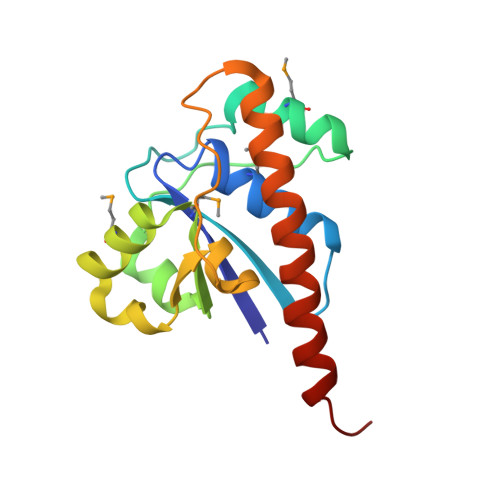Chasing phosphoarginine proteins: development of a selective enrichment method using a phosphatase trap.
Trentini, D.B., Fuhrmann, J., Mechtler, K., Clausen, T.(2014) Mol Cell Proteomics
- PubMed: 24825175
- DOI: https://doi.org/10.1074/mcp.O113.035790
- Primary Citation of Related Structures:
4PIC - PubMed Abstract:
Arginine phosphorylation is an emerging post-translational protein modification implicated in the bacterial stress response. Although early reports suggested that arginine phosphorylation also occurs in higher eukaryotes, its overall prevalence was never studied using modern mass spectrometry methods, owing to technical difficulties arising from the acid lability of phosphoarginine. As shown recently, the McsB and YwlE proteins from Bacillus subtilis function as a highly specific protein arginine kinase and phosphatase couple, shaping the phosphoarginine proteome. Using a B. subtilis ΔywlE strain as a source for arginine-phosphorylated proteins, we were able to adapt mass spectrometry (MS) protocols to the special chemical properties of the arginine modification. Despite this progress, the analysis of protein arginine phosphorylation in eukaryotes is still challenging, given the great abundance of serine/threonine phosphorylations that would compete with phosphoarginine during the phosphopeptide enrichment procedure, as well as during data-dependent MS acquisition. We thus set out to establish a method for the selective enrichment of arginine-phosphorylated proteins as an initial step in the phosphoproteomic analysis. For this purpose, we developed a substrate-trapping mutant of the YwlE phosphatase that retains binding affinity toward arginine-phosphorylated proteins but cannot hydrolyze the captured substrates. By testing a number of active site substitutions, we identified a YwlE mutant (C9A) that stably binds to arginine-phosphorylated proteins. We further improved the substrate-trapping efficiency by impeding the oligomerization of the phosphatase mutant. The engineered YwlE trap efficiently captured arginine-phosphorylated proteins from complex B. subtilis ΔywlE cell extracts, thus facilitating identification of phosphoarginine sites in the large pool of cellular protein modifications. In conclusion, we present a novel tool for the selective enrichment and subsequent MS analysis of arginine phosphorylation, which is a largely overlooked protein modification that might be important for eukaryotic cell signaling.
- From the ‡Research Institute of Molecular Pathology - IMP, Dr. Bohr-Gasse 7, A-1030 Vienna, Austria;
Organizational Affiliation:



















